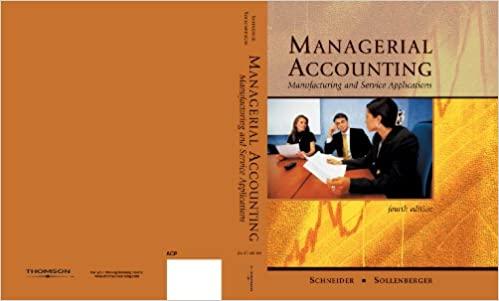Question
14. The primary objective of financial accounting is to: Serve the decision-making needs of internal users. Provide accounting information that serves external users. Monitor consumer
14. The primary objective of financial accounting is to:
- Serve the decision-making needs of internal users.
- Provide accounting information that serves external users.
- Monitor consumer needs, tastes, and price concerns.
- Provide information on both the costs and benefits of looking after products and services.
- Know what, when, and how much product to produce.
Answer
15 The area of accounting aimed at serving the decision making needs of internal users is:
- Financial accounting.
- Managerial accounting.
- External auditing.
- SEC reporting.
- Bookkeeping
Answer ...
16. External users of accounting information include all of the following except:
- Shareholders.
- Customers.
- Purchasing managers.
- Government regulators.
- Creditors.
Answer
17. The accounting concept that requires every business to be accounted for separately from other business entities, including its owner or owners is known as the:
- Time-period assumption.
- Business entity assumption.
- Going-concern assumption.
- Revenue recognition principle.
- Measurement (Cost) principle.
18. If a company is considering the purchase of a parcel of land that was acquired by the seller for $85.000, is offered for sale at $150,000, is assessed for tax purposes at $95,000, is considered by the purchaser as easily being worth $140,000, and is purchased for $137,000, the land should be recorded in the purchaser's books at:
A) $95,000.
B) $137,000.
C) $138,500.
D) $140,000.
E) $150,000
Answer ....
19. The rule that (1) requires revenue to be recognized when goods or services are provided to customers and (2) at the amount expected to be received from the customer is called the:
- Going-concern assumption.
- Measurement (Cost) principle.
- Revenue recognition principle.
- Objectivity principle.
- Business entity assumption.
Answer
20. Revenue is properly recognized:
- When the customer makes an order.
- Only if the transaction creates an account receivable.
- At the end of the accounting period.
- When goods or services are provided to customers and at the amount expected to be received from the customer.
- When cash from a sale is received
Answer ....
21. If a company uses $1,300 of its cash to purchase supplies, the effect on the accounting equation would be:
- Assets increase $1,300 and liabilities decrease $1,300.
- One asset increases $1,300 and another asset decreases $1,300, causing no effect.
- Assets decrease $1,300 and equity decreases $1,300.
- Assets decrease $1,300 and equity increases $1,300.
- Assets increase $1,300 and liabilities increase $1,300.
Answer
22. If a company purchases equipment costing $4,500 on credit, the effect on the accounting equation would be:
- Assets increase $4,500 and liabilities decrease $4,500.
- Equity decreases $4,500 and liabilities increase $4,500.
- One asset increases $4,500 and another asset decreases $4,500.
- Assets increase $4,500 and liabilities increase $4,500.
- Equity increases $4,500 and liabilities decrease $4,500.
23. If equity is $300,000 and liabilities are $192,000, then assets equal:
A) $108,000.
B) $192,000.
C) $300,000.
D) $492,000.
E) $792,000.
Answer .......
24. Distributions of cash or other resources by a business to its owners are called:
- Withdrawals.
- Expenses.
- Assets.
- Retained earnings.
- Net Income
Answer
25. Adjusting entries:
- Affect only income statement accounts.
- Affect only balance sheet accounts.
- Affect both income statement and balance sheet accounts.
- Affect cash accounts.
- Affect only equity accounts.
Answer
26. An optional aid used to prepare a company's unadjusted trial balance, adjusting entries, adjusted trial balance, and financial statements is a(n):
- Adjusted trial balance.
- Work sheet.
- Post-closing trial balance.
- Unadjusted trial balance.
- General ledger
Answer
27. Closing entries are required:
- If management has decided to cease operating the business.
- Only if the company adheres to the accrual method of accounting.
- If a company's bookkeeper does not choose to prepare reversing entries.
- If the temporary accounts are to reflect correct amounts for each accounting period.
- In order to satisfy the Internal Revenue Service guidelines.
Answer
28. Which of the following accounts is a permanent account?
- Fees earned.
- Office supplies expense.
- Interest revenue.
- Accounts payable.
E) Salaries expense
Step by Step Solution
There are 3 Steps involved in it
Step: 1

Get Instant Access to Expert-Tailored Solutions
See step-by-step solutions with expert insights and AI powered tools for academic success
Step: 2

Step: 3

Ace Your Homework with AI
Get the answers you need in no time with our AI-driven, step-by-step assistance
Get Started


